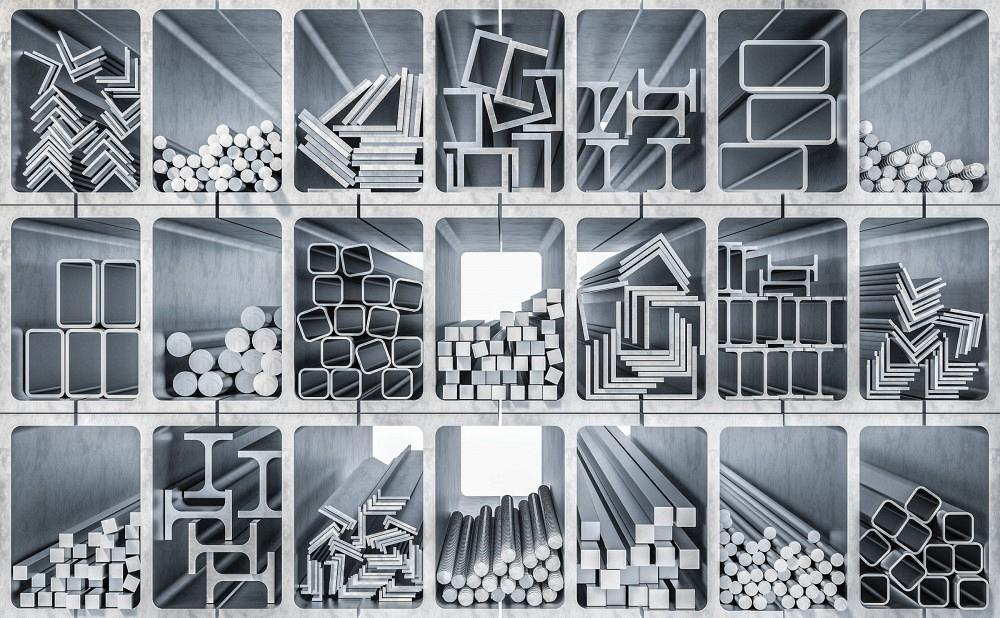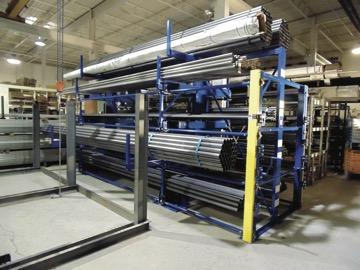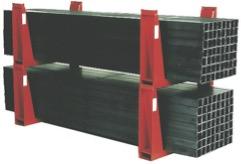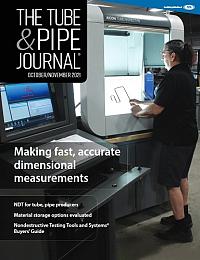Vice President of Marketing
- FMA
- The Fabricator
- FABTECH
- Canadian Metalworking
Categories
- Additive Manufacturing
- Aluminum Welding
- Arc Welding
- Assembly and Joining
- Automation and Robotics
- Bending and Forming
- Consumables
- Cutting and Weld Prep
- Electric Vehicles
- En Español
- Finishing
- Hydroforming
- Laser Cutting
- Laser Welding
- Machining
- Manufacturing Software
- Materials Handling
- Metals/Materials
- Oxyfuel Cutting
- Plasma Cutting
- Power Tools
- Punching and Other Holemaking
- Roll Forming
- Safety
- Sawing
- Shearing
- Shop Management
- Testing and Measuring
- Tube and Pipe Fabrication
- Tube and Pipe Production
- Waterjet Cutting
Industry Directory
Webcasts
Podcasts
FAB 40
Advertise
Subscribe
Account Login
Search
Options for Pipe Storage and Tube Storage
Choices abound for fabricators when it comes to storage density, safety, ease of access, cost
- By Scott Stone
- Updated January 24, 2023
- October 19, 2021
- Article
- Materials Handling

For common, everyday storage of long loads, tube and pipe fabricators have several choices. Finding one with the best combination of safety, cost, storage density, and accessibility is a matter of understanding the features and benefits of each. Getty Images
Since the earliest days of modern industry, manufacturers have sought the most efficient ways to store everything—raw materials, intermediate and finished goods, tooling, consumables, and supplies. In many cases, the common pallet works wonders.
A pallet unitizes and standardizes storage units. Standard-sized items are easier to store and handle than a series of items that vary in dimensions, so palletizing is efficient in both storage and handling. As long as the pallet dimensions match the rack dimensions and the fork trucks can handle the pallet sizes and weights, the storage system meets two key criteria: excellent storage density and easy access.
Storing long loads, especially items like tube and pipe, is an exception. They’re too long and usually too heavy to be palletized. Thankfully, many other storage systems exist. Finding the best storage option depends on a combination of factors, including safety, storage density, storage system access, and cost, ranked here from 1 (least favorable) to 5 (most favorable).
Cantilevered Tube and Pipe Racks
A cantilevered system is the default choice for long parts. Such a rack can be installed indoors or outdoors, comes in practically limitless configurations and capacities, and is economical for its combination of storage density, accessibility, and safety.
Cost – A cantilevered rack is a cost-effective method for pipe storage. It can range from a few hundred dollars to several thousand per rack, depending on the height, capacity, and length. Even if the application doesn’t lend itself to a standard unit, a custom-engineered unit usually isn’t cost-prohibitive. Because this sort of rack tends to be durable, it usually can perform for many years, even in tough outdoor applications.
Space Efficiency – Although a cantilevered rack can store a variety of product sizes and shapes, long parts like pipe and tubing are really its best application. The rack excels in using the vertical dimension, so compared to other methods, it conserves floor or yard space. A tradeoff is that the layout has to include some space in front of each rack for fork truck access.
Load Accessibility – A cantilevered system provides excellent access to every storage location on the rack at all times. It can be loaded or unloaded with forklifts, stackers, hoists, or by hand. Static arm positions may obstruct the lower ones in some hoist handling operations, but this is a small drawback given the ease of access.
Safety – If properly specified, a cantilevered rack can hold extremely heavy loads. It’s considered a safe method for storage, loading, and unloading, but workers need to be cautious when handling any large, unwieldy, long items, whether racked or not. While elevated loads can always fall because of mishandling or equipment failure, this isn’t common so long as the rack is specified for the load, used correctly, and inspected on a regular basis.
Crank-out Cantilevered Racks

A cantilevered rack provides a very good combination of characteristics for tube or pipe storage. In addition to its favorable cost, accessibility, and safety record, it can be built upward by adding more levels. The vertical limit is the height of the lifting device used to retrieve the material. Cisco-Eagle.
Crank-out racks have many of the same design and accessibility options as the static cantilevered rack but offer potentially more storage density for heavy, long loads.
Cost – Crank-out racks aren’t inexpensive. These racks are deployed in high-density applications in which cost isn’t as important as space utilization. They often go into workcells in manufacturing plants where fast access to stored items is critical enough to justify the added expense. This is the most expensive option for storing long parts.
Space Efficiency – Crank-out racks provide excellent space utilization. They retract the load into rack structure, allowing for tight, unitized storage of long items like steel tubes and pipes. When placed beside fabrication machinery, they help keep machine time to a minimum and maximize critical square footage in and around workcells.
Load Accessibility – These racks allow full access to all stored items 100% of the time. Usually this is accomplished by hand for lighter loads and by hoists for heavier, bulkier ones.
Safety – The crank-out rack has a very good safety track record. Because it retracts loads into a single rack unit, the chances of spills or drops is limited. Being able to extend the rack arms out fully helps workers avoid injuries from overreaching and lifting heavy items from less-than-optimal positions, which can lead to fewer workers’ compensation claims.
Only one level of a crank-out rack can be extended at a time. This built-in safety feature prevents the rack from tipping over.
Stacking Pipe and Tube Storage Racks
Stacking racks come in a variety of configurations and are strong for long parts storage applications. Unlike cantilevered racks, stacking racks aren’t permanently installed and aren’t bolted to concrete. This provides flexibility in dimensions but offers fewer options for loading and unloading. They are ideal for fluid situations in which inventory items are moved around frequently and the system needs adaptability.
They offer good capacities, supporting loads from 2,500 to 7,500 lbs. Longer, heavier loads can be supported by adding more stacking racks to the row.
Cost – Stacking racks tend to cost less than cantilevered racks, but they generally aren’t as long. Therefore, the investment must include additional units to accommodate greater lengths of stock or tubing.

Although crank-out cantilevered racks aren’t inexpensive, they provide an excellent combination of storage density, accessibility, and safety. Rack Engineering Inc.
Space Efficiency – Stacking racks provide good storage density. They stack (depending on type) four to six layers high—typically not as high as a cantilevered system but higher than many ground-stacking applications.
Load Accessibility – Accessibility is limited. Stacking racks are layered atop each other up to 10 units, depending on the model. Most stacking racks limit access only to the ends because the layer above prevents a forklift or hoist from lifting the load upward. The tube or pipe must be pulled out from an end.
Another unloading option is to unload an entire layer to reach the tubing at lower layers. This is fine if a particular run of stacking racks have exactly the same load on all levels, but more problematic if the loads are mixed.
Safety – Stacking racks often are loaded and unloaded by hand. Generally this is safe, but whenever a worker handles heavy loads, a safety and ergonomic review is warranted. Racks shouldn’t be stacked too high or loaded with materials that are too heavy for manual handling.
Forklifts can be used to load and unload stacking racks by sliding the forks beneath the pipe and between two columns of racks beneath the pipe. This takes great care because the racks are modular and not secured to the floor. With one wrong move, the driver could upend a stacking rack or series of them.
If applied to the right load in the right situation, a stacking rack system is a good, safe option, as long as it isn’t overloaded.
Floor or Ground Stacking
When tube, pipe, and other long products are stacked on a floor, they often are banded or placed between structures such as pillars or bollards to prevent sliding and rolling. Floor storage is acceptable for bundles or slow movers that sit near processing machinery or otherwise need to be accessed by hand with ease.
Cost – Stacking product on the floor or the ground is exactly what it says it is, and it’s essentially free. The main requirement is having a large enough space to accommodate the load. A secondary one is an investment in bollards or a similar system to prevent rolling or sliding.
Space Efficiency – A stack of inventory on a floor has a vertical limit, so such a stacking method makes poor use of vertical space. It also consumes floor space that might be useful for something else. Also, mixing loads in a single stack of inventory is problematic. It saves space but wastes time when the item needed next is on the bottom of the stack.

Although stacking racks don’t provide the best in storage density and accessibility, they excel in versatility. Because they aren’t permanently installed, they can be used, emptied, and set up in new locations and in different configurations as needs change. Jarke Inc.
Load Accessibility – Depending on how the inventory workers pick raw materials to fill orders, the load accessibility can be acceptable. Most of the time, floor loads are picked by hand or with a hoist. A fork truck’s tines can’t get beneath a pipe in a stack easily and sometimes can’t get the right angle for retrieval. However, floor storage isn’t bad for light loads that can be picked by hand.
Safety – This storage method has some risk. Unsecured stacks of round objects are inherently unsafe unless contained, so any floor stack must have structural limiters that prevent rolling. If banded, workers need protection from shifting loads when snipping the bands.
A benefit is that loads on the ground can’t fall. The only threat is from sliding or shifting. Relying on blocks or banding for load security means workers have to cope with those measures each time they access the stack.
Safety Comes First When Storing Pipes and Tubes
These are among the most common methods for storing tube, pipe, and other long products, but these aren’t the only ways to do it. Long loads have been stored in welded cube structures and on pallet racks, while workstations and vertical racks handle smaller, hand-loaded applications. Some fabricators even make their own systems.
Finding the best solution for every application can take some research. A low-cost or home-made system can do the job, but despite any restrictions in size, space, and budget, safety always should be the first consideration. As the dimensions and weights of the stored product increase, the risks associated with rolling, shifting, and falling pipes grow, as does the importance of an inherently safe system.
About the Author
Scott Stone
2120 Valley View Lane
Dallas, TX 75234
972-406-9330
About the Publication
Related Companies
subscribe now

The Tube and Pipe Journal became the first magazine dedicated to serving the metal tube and pipe industry in 1990. Today, it remains the only North American publication devoted to this industry, and it has become the most trusted source of information for tube and pipe professionals.
start your free subscription- Stay connected from anywhere

Easily access valuable industry resources now with full access to the digital edition of The Fabricator.

Easily access valuable industry resources now with full access to the digital edition of The Welder.

Easily access valuable industry resources now with full access to the digital edition of The Tube and Pipe Journal.
- Podcasting
- Podcast:
- The Fabricator Podcast
- Published:
- 04/16/2024
- Running Time:
- 63:29
In this episode of The Fabricator Podcast, Caleb Chamberlain, co-founder and CEO of OSH Cut, discusses his company’s...
- Trending Articles
Zekelman Industries to invest $120 million in Arkansas expansion

3D laser tube cutting system available in 3, 4, or 5 kW

Corrosion-inhibiting coating can be peeled off after use

Brushless copper tubing cutter adjusts to ODs up to 2-1/8 in.

HGG Profiling Equipment names area sales manager

- Industry Events
16th Annual Safety Conference
- April 30 - May 1, 2024
- Elgin,
Pipe and Tube Conference
- May 21 - 22, 2024
- Omaha, NE
World-Class Roll Forming Workshop
- June 5 - 6, 2024
- Louisville, KY
Advanced Laser Application Workshop
- June 25 - 27, 2024
- Novi, MI


























